#me back posting weird sh*t in series tag
Photo


mmm yeah
(contemplates life choices)
#random#GARO: Makai no Hana#garo: goldstorm#me back posting weird sh*t in series tag#sob the skirts are tiny#my brain and me
6 notes
·
View notes
Text
Writing In Eternian
Hey! I made a post about a little season 5 easter egg yesterday (not linking it here because for some reason it blocks the post from showing in the tags)and while I was poking through the tags, I noticed that a lot of people want to learn how to use First Ones writing! Writing and orthography are actually things I'm really interested in, so I decided to make this guide for people. It's a bit more in-depth than the official press release, so if you just want to use that, feel free!
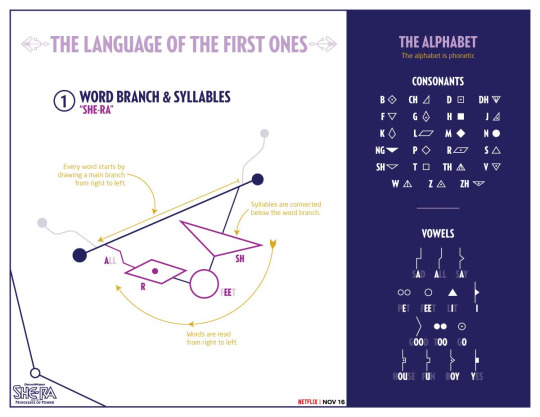
Here’s the original tweet from the She-Ra Twitter account, which has more examples: twitter. com /dreamworksshera/status/1055474341553623040
Here we go! Putting it under a break so it doesn't eat up your whole screen.
THE SOUNDS OF ENGLISH & THE IPA
So first of all, we need to start with a brief introduction to the IPA. (If you’re already familiar, you can skip to the next big heading.) Lots of languages use a lot of different letters or other characters to represent certain sounds, but when you're working with linguistics, you need to be able to say exactly what you mean. So, we made the International Phonetic Alphabet. This is a long list of individual letters and markings that represent very specific sounds, and you use them by placing them between slashes, like /d/, and sometimes to distinguish, you place the actual writing between corner brackets, like <d>. So for instance, /t/ and /h/ make the same sounds that <t> and <h> make in English, but <th> (usually) makes either the /θ/ or /ð/ sounds. These change based on where you live, but in general the consonants are the same for all English speakers.
Knowing this is important, because something I love about the First Ones alphabet is that it isn't just a letter substitution! Many "secret language" alphabets I've seen in kid's series (like Artemis Fowl, for instance) are just simple one-to-one substitutions for the Latin alphabet we use. But First Ones writing is actually very different! It uses the actual sounds made in the word. So if you wrote "cat" in the First Ones script (which I'm gonna call Eternian, after Eternia from He-Man, which flows better than "First Ones script"), it would actually look like "kat", because the letter c can be used for the sounds k or s, so it doesn't translate.
The alphabet we're using right now was created for the Latin language, derived from the Greek alphabet, which itself has a very long history behind it. English is NOT descended from Latin - it's a Germanic language, and the Germanic family is only kind of related to the Romantic family that developed out of Latin. However, a lot of our vocabulary has a Latin infusion because of mixing with Old French in the 1000s-1100s, and even before that, we used the Latin alphabet because it was the most common. This means that in order to express all the sounds we have, English speakers writing English had to combine different letters together; this, plus over a thousand years of different spellings and dialects, means that our orthography - our way of writing the sounds we say - is FUCKED. The Eternian alphabet is actually a much more efficient way of writing these sounds!
This is the total list of English consonants:

A few notes here:
To make sure you're not lost, /ŋ/ is <ng>, /j/ is <y>, /θ/ and /ð/ are <th>, /ʃ/ and /ʒ/ are <sh> and <zh> (the French <j>, not usually distinguished in English writing) respectively, and /tʃ/ and /dʒ/ are <ch> and the English <j> respectively.
Most consonants can come in voiced and unvoiced versions (although, because English is weird, these are called "fortis" and "lensis" because we pronounce them with different amounts of energy). /b/ is /p/, but pronounced using the vocal chords. Only the nasal sounds, the "approximants", and /h/ don't have pairs in English, although /h/ DOES actually have a common voiced pair, and you can technically pronounce the others voiceless in some languages although it's very rare.
The /x/ sound, famously the end of the Scottish word "loch", is only found in Celtic accents (Scottish, Irish, Welsh) and in the South African accent (because of influence from Dutch). Other English speakers realize it as /k/.
The /r/ sound is weird. What /r/ technically represents is a trill, like in the Spanish <rr>. However, in English, that trill is very rare; what we use <r> for is called a "postalveolar approximant", [ɹ̠]. However, it is usually easier just to write the letter r, so that's how we transcribe it for English's IPA.
English also sometimes has what are called "syllabic consonants", which are consonants that can act as the center of a syllable in the place of a vowel. In English, these are mostly /l/, /m/, and /n/. For instance, the word "bottle" is technically pronounced [ˈbɑɾl̩] in General American English, and the same goes for words like "rhythm" and "button"; however, because this would complicate things a lot, phonologists consider it to include a very small vowel, so with the example of "bottle", it would be /ˈbɑtəl/ instead.
The vowels are a bit more weird than the consonants. Our alphabet was originally created for Latin, which only has ten vowel sounds, long and short a, e, i, o, and u (although technically the short vowels are /a ɛ ɪ ɔ ʊ/ instead of /a e i o u/, because fuck it I guess). However, we have a MUCH different vowel "inventory" in English - instead of the uniform 10 paired Latin vowels, in General American English we have anywhere from 11-13 vowels depending on your interpretation along with three diphthongs (combinations of two vowels used as a single vowel):

If you look at the British (Received Pronunciation) chart it's much different from that, which is why the accents are so distinct; however, Eternian is made with GA English in mind, so I'm just going to focus on that.
More notes:
/ə/ (a schwa, like in "uh"), /ɜ/ (very similar and hard to distinguish in writing), and /ʌ/ (something between an "uh" and an "ah"), are all very close to each other and sometimes interchangeable, especially between the first two.
/oʊ/ is usually simplified to /o/, and /eɪ/ is sometimes simplified to /e/, since the normal versions of those sounds don't show up so we don't have to make the difference clear.
A lot of accents in North America make /ɔ/ sounds (similar to "aw" or "au", like in "caught") into /ɑ/ sounds (the o in "hot").
Now, let's move on to the alphabet!
ETERNIAN GLYPHS & SIGILS
The "letters" of the Eternian alphabet, in my opinion, are better described using the more general term "glyph". This is because, while they are distinct shapes that mean specific sounds, they are used kind of artistically and variably within one large interconnected word-shape called a "sigil", much different than we would consider letters in the English alphabet. These glyphs are organized in words by lines starting at the basic shape of the sigil and stringing them together in order.
Eternian glyphs are split into two major categories that differ by shape: consonants and vowels.
CONSONANTS
The system of glyphs for Eternian consonants is actually very easy to remember, once you get the shapes down! Let's go back to the voiced/voiceless pairs. English has eight pairs of these, four plosives (made by quickly starting and stopping air with your mouth) and four fricatives (made by constantly moving air through your mouth). These eight pairs - along with another pair for /r/ and /l/ even though they aren't voiced/voiceless, because they're also closely related - make up most of the sounds in English and most of the consonant glyphs in Eternian. In each of these pairs, the voiceless (and /l/) have a basic, empty polygon shape; the voiced pair (and /r/) use the exact same shape, but with a dot in the middle. Like so:
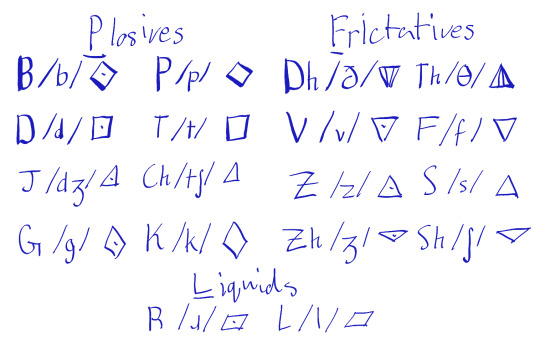
Outside of this, English has four more vowels - /m/, /n/, /ŋ/, and /h/ - and two "semivowels", which can be used either as a vowel or a consonant. One of these semivowels, /j/ (the English y), is used as a vowel in Eternian, while the other, /w/, is treated as a consonant. Except for /w/, these remaining consonants are all marked by the fact that they’re solid color; they also all use the same basic shapes as many of the others, but aren’t related to the sounds which share their shape:

Pretty simple once you get the hang of it! Excuse the messiness; if you want a more precise rendering, you can reference the original release at the top.
I'm pretty sure this is all accurate, but there's one thing that seems weird to me. In English, <th> can be used to express either voiceless /θ/ or voiced /ð/. However, in Eternian, they gave us a "dh" glyph. I assume that this is meant to represent /ð/. However, in Wrong Hordak's "Smooch The Chef" apron, "the" is spelled with the glyph used for /θ/. But honestly I'm just assuming human error on that one, especially because /ð/ is very rare at the beginning of words except for articles or pronouns like the and these, most cases of <th> at the beginning of a word are /θ/ like in "thorn".
Now, for vowels!
VOWELS
Like I said earlier, this bit is much more complicated to get than the consonants, but luckily, this is actually much better for English than Latin letters!
Eternian vowel glyphs are divided, seemingly at random, into two subsets with a single exception. First are line-glyphs, which are formed by altering the connective line between two geometric glyphs. The others are circle-glyphs, the ones used for /ɛ/, /i/, /u/, and /o/. These function in the exact same way as the consonant glyphs, except that they are all circles where none of the consonants (except /n/) are.
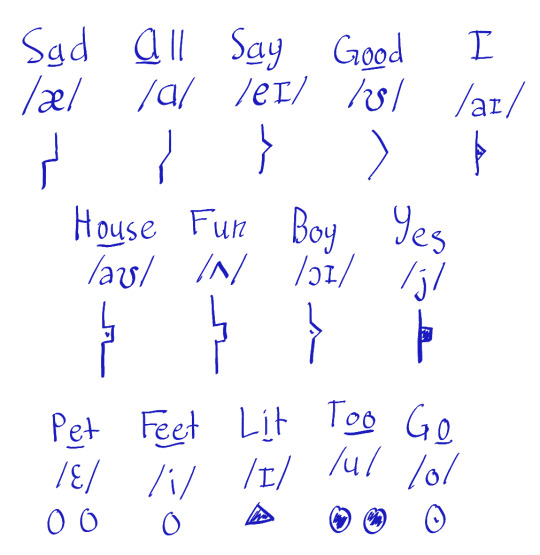
There's a few issues here with transcribing words, but they mostly come out of simplifying English's horrible vowel fluidity. For instance, there's no distinct letter for writing the schwa /ə/, but it can be folded into the letter for /ʌ/. That, and combining /ɔ/ with /ɑ/, simplify 16 sounds into 13 letters. The last letter, /j/, is the other semivowel I mentioned above; <y> in English can be used for either /j/ or /aɪ/ and /ɪ/, but this letter specifically represents the /j/ sound like in "yes" or "yak".
BRINGING IT TOGETHER
This is where things get very interesting. Let's start with the basics, walking through how to write the word "Adora".
Eternian, as a writing system, is much more artistic by design than Latin, and words and sentences can be constructed in many ways which are all read the same way. Eternian words - better called "sigils" - are read right-to-left, like Hebrew, Arabic, or traditional Japanese and Chinese. We form the sigils starting with a line sloping down in that direction book-ended with dots. The exact angle and length doesn't matter, but the right side is always noticeably higher than the left, like this:

We then add two additional decorative lines built off of that base, which end in dots:

These flourishes can be curved, geometric, or a mix of both, and often inform a lot about the "personality" of both a sigil and its writer, and can distinguish one sigil from another. They're like the sigil's signature. They can be any shape or length, but never overlap with themselves or other lines.
The next step is to begin adding the sounds. Much like the flourishes, these are constructed differently for every sigil, although again they are all read from right-to-left and the symbols are placed with that in mind. These are strung down from the sigil's base, connecting with straight lines. Let's start by placing the a-sound in "Adora" near the right-side edge of the line (this is the /ʌ/ line-glyph, like the u in "fun"):
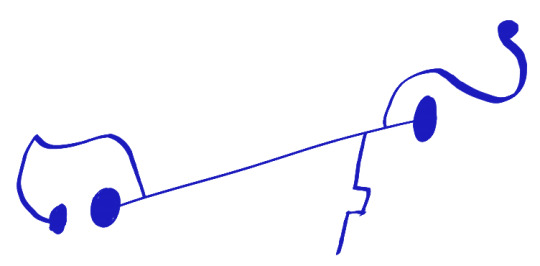
Because the /ʌ/ glyph is a line, it replaces the normal connecting line. Let's finish this syllable line with the /d/ glyph:

...and then add another line with the glyphs for /orʌ/:

Generally, when a cluster ends with a line-glyph, it connects back to the base line. Clusters not at the end cannot end on a line-glyph (though I'm not sure about what to do for line-glyph-only words like "I" or "a" - perhaps the base line is changed, the line curves in an arc, or it ends at the changed portion?). Additionally, line-glyphs are always turned in the direction they're going - the beginning and ending /ʌ/ glyphs are flipped from each other, because the ending glyph is turned upwards going towards the base line while the beginning is stemming from it.
The important thing to remember is that sigils can be formed in a variety of ways - the flourishes, line angles, how you structure the syllables, all of these are dependent on the writer, so long as they follow those general rules. I constructed that sigil “AD.ORA”, but it could just as easily be “ADO.RA”, and in larger words there’s much more potential for structural changes.
Sigils in a sentence are connected through lines which meet the word next to each of the flourishes, and which bend to fit the shape of the sentence. Sentences are not read in any specific direction, but words are clustered in aesthetically pleasing ways and sentence order is shown by these connecting lines. However, The initial word in a sentence only has a line connecting on its left side, the final word only has a line on its right side, and words in between connect to the previous word on their right and the next word on their left.
Let's try extending this to a simple sentence - "Adora is She-Ra." We already have the She-Ra sigil from canon, so we just need to connect them with the word "is".
First, let's write the next word, below and to the left:

And connect the two with a line:

And then repeat with the "She-Ra" sigil.
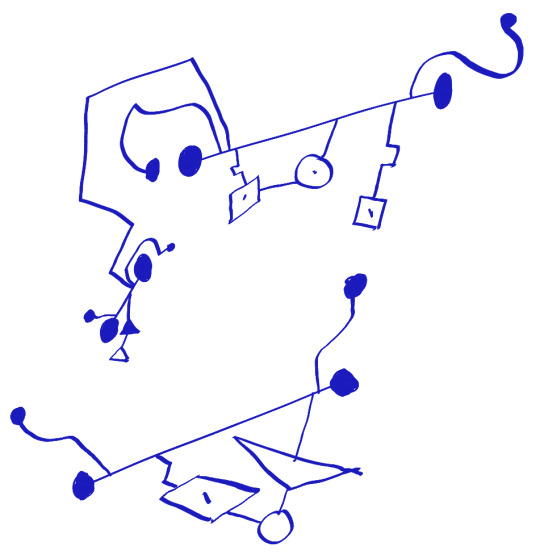
...and finally...
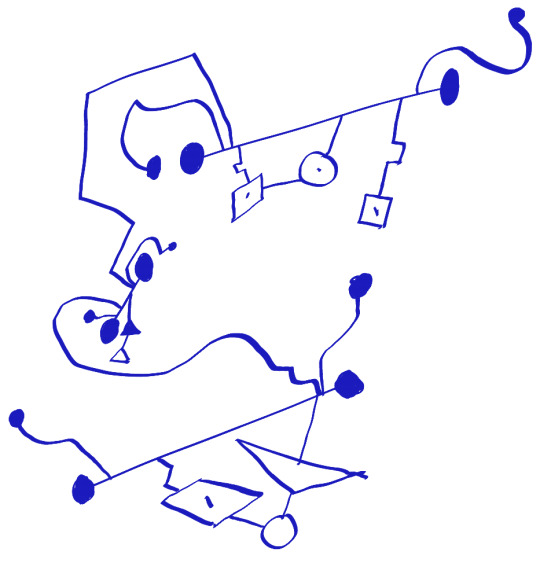
There we go! You've officially written a sentence using Eternian glyphs! I hope you have fun with it! If you have any questions feel free to shoot me an ask. Thanks for reading!
232 notes
·
View notes
Photo

REVOLUTION | 1.03
There’s a part of you that still gives a crap.
You’re wrong.
#nbc revolution#Billy Burke#Miles Matheson#GIF set#Mine#1.03#Cube life#I don't know if this is the start of a series I'm very fickle#I don't know if I've ever said this but I sort of took Miles's attractiveness for granted until ep 5#Billy was just ridiculously good looking in 1.05 and 1.06#and I think it's the hair length but it has to be more than that#and he's nice here too#obviously... but yeh sh*t got real in 1.05#I haven't posted Revo in soooooo long and I always use the 'Not Revo' tag because I want to remind myself that I should post more#until the guilt builds up and I gif something#and it's weird watching little scenes now because the writing's a little weak compared to Westworld or Dark Matter#I have S1 in my head as this perfect little space that could never be improved on... but yeh I guess they could have written the first 10#better they had the bones of a brilliant story.... they had the chemistry between the actors... and a network budget#But oh well... I don't know whether I'm going to go stare at 1.05 or run to 1.09#the shipper in me thinks I should go back to my Marlie roots#and omg I'm sure no one cares but I'm really happy Tracy'll be guesting on Chicago PD. I can't believe she hasn't got a show yet.
60 notes
·
View notes
Text
Writing Review
The lovely and talented @roguelioness tagged me - thank you! I’ll do my best.
Words written in 2018: It’s difficult to say, because @auroraborealia and I write a lot of stuff that’s just for our own enjoyment, one of my Dragon Age stories will not be published until it’s finished, and my history blog doesn’t keep a word count really. But going strictly by what I posted to AO3: 439,817.
Number of short fic written in 2018: Five pieces on AO3, plus two unpublished stories in Google docs.
Number of fic chapters written in 2018: I honestly can’t answer this, because a lot of the Skyhold Academy Yearbook stuff was written in 2017 but got published in 2018, and a lot of it was written in 2018 but will be published in 2019, so it’s all a bit jumbled.
Number of chaptered fic completed in 2018: Three - Disorienuptials (it was all written in 2017 but the last couple chapters were posted in early 2018 so it counts right?), The Memory Band, and Life is a Roller Coaster. These are all installments for Skyhold Academy Yearbook.
Fandoms: Mostly Dragon Age, although I did update my current Beetlejuice series installment once during 2018.
Parings: Varric/Bethany (I know you are shocked), Cullen/f!Trevelyan, Dorian/Iron Bull, Krem/OC, Krem/Rosalie Rutherford
Proudest achievements: I started my Pennsylvania history blog back in May and I’m extremely proud of it. It doesn’t have a massive readership, but it’s steadily growing and the quality of the work is sound. I also continue to be very proud of my fic for @tk31085, All This Sh*t is Twice as Weird, and I’m super happy with that unpublished DA story, which is a legitimate contender for the best thing I’ve ever written.
Writing resolutions for 2019: Finish things. Especially original things.
I’m not sure who all has done this one, so if you want to do it, feel free!
4 notes
·
View notes
Text
#MeTooSTEM founder admits to creating Twitter persona who “died” of COVID-19

Enlarge / Twitter drama erupted over the weekend when a much-beloved online persona supposedly died of COVID-19 complications—only to be exposed as a fake account/catfishing scheme by controversial neuroscientist and #MeTooSTEM founder BethAnn McLaughlin.
A segment of science Twitter was rocked over the weekend by the discovery that a long-standing, pseudonymous online member had died of COVID-19-related complications. But grief quickly turned to shock, hurt, and anger when the deceased turned out to have never existed. Rather, it was a sock puppet account that we now know was created and maintained by BethAnn McLaughlin, a neuroscientist and founder of the #MeTooSTEM advocacy group whose Twitter handle is @McLNeuro.
“I take full responsibility for my involvement in creating the @Sciencing_Bi Twitter account,” McLaughlin said in a statement provided to The New York Times through her lawyer. “My actions are inexcusable. I apologize without reservation to all the people I hurt. As I’ve reflected on my actions the last few days, it’s become clear to me that I need mental health treatment, which I’m pursuing now. My failures are mine alone, so I’m stepping away from all activities with #MeTooSTEM to ensure that it isn’t unfairly criticized for my actions.”
This certainly isn’t the first time a fake persona has manifested on social media. Way back in 2003, controversial American Enterprise Institute scholar John R. Lott Jr.. was outed by The Washington Post for creating a sock-puppet online persona, “Mary Rosh,” purportedly a former student, and using it to mount spirited defenses of his work online. In 2017, there was the case of “Jenna Abrams,” who boasted 70,000 Twitter followers; the fake persona was so convincing that she managed to spread a viral rumor that CNN’s local Boston station had accidentally aired 30 minutes of pornography late one night in November 2016.
In 2019, we had the strange case of Eugene Gu, a former surgery resident at Vanderbilt University Medical Center who went viral on Twitter a few years ago after taking a knee in his hospital scrubs in solidarity with Colin Kaepernick. An investigation by The Verge revealed evidence that Gu operated several sock puppet Twitter accounts, most notably one under the name @MaryLauryMD (since deleted). And just last month, The Daily Beast exposed a network of fake op-ed writers who had been placing editorials on Middle East policy with conservative outlets, such as Newsmax and the Washington Examiner.
But the particular case of @Sciencing_Bi is unique because of its unusually long duration—the Twitter account was created in October 2016—and the absence of any obvious financial motive that is a common feature of catfishing scams.
“I’ve been acquainted with that account for years, and nothing seemed unusual about it,” Greg Gbur told Ars. He’s a physicist at the University of North Carolina at Charlotte, and he interacted occasionally with @Sciencing_Bi on Twitter. He never noticed anything amiss. “She seemed like a nice person, passionate about STEM representation. No indication of a scam for money or anything like that. It’s all a bit mystifying.”
Tweets and sympathy
Screen cap of @Sciencing_Bi tweet detailing her struggles with COVID-19.
Greg Gbur
@Sciencing_Bi tweet: “Anyone want to guess my hospital bill for my in patient stay in the ICU for 15 days?”
Greg Gbur
@Sciencing_Bi tweet: “I need a solid comeback to people telling me how lucky I was to get COVID-19 early.”
Greg Gbur
@Sciencing_Bi tweet: “Still struggling hard with recovery”
Greg Gbur
@McLNeuro (BethAnn McLaughlin) tweet announcing death of @Sciencing_Bi.
Jennifer Ouellette
@McLNeuro tweet: “It just didn’t occur to me that she’d die.”
Jennifer Ouellette
@McLNeuro tweet: “She wanted me to get a tattoo that matched hers”
Jennifer Ouellette
@McLNeuro tweet: “She was forced by her university to teach in person until April.”
Jennifer Ouellette
@Sciencing_Bi, identified on her profile only as “Alepo,” claimed to be a female bisexual Native American anthropologist at Arizona State University who was involved with combatting discrimination and sexual harassment in the scientific community. She had a modest follower count (about 2,400) and interacted frequently with several well-known scientists, science writers, and science communicators on Twitter. (Full disclosure: while I never interacted with the account myself, I know many of those on science Twitter who did.)
In April, she announced that she had contracted COVID-19 and subsequently documented a months-long struggle with the disease. She specifically blamed her employer, ASU, for her plight, and she claiming that she and other teachers, staff, and students had been forced to remain on campus well into April. She also asserted that the school had cut her salary by 15 percent while she was hospitalized. Then on Friday, July 31, McLaughlin tweeted that @Sciencing_Bi—purportedly a close friend—had died of complications from COVID-19, followed by a series of impassioned tweets eulogizing her late friend.
There was the usual online outpouring of condolences and grief alongside outrage at her plight and purported mistreatment by ASU. McLaughlin even set up a Zoom memorial service for @Sciencing_Bi; those attending included noted University of California, Berkeley, biologist Michael Eisen and Melissa Bates, a physiologist at the University of Iowa.
Huh.
That’s when things got weird. Both Eisen and Bates were surprised that only five people, including themselves and McLaughlin, attended the virtual memorial—no former students, no colleagues, no friends, and no family members. As Bates noted in a twitter thread, “This is a community. And if this person was part of the community, where was the community?” Bates’ suspicions were aroused in earnest when McLaughlin told her that Sciencing_Bi had mentioned her in her will. “You don’t leave sh*t to randos on the Internet when you’re first gen and you’ve got an undocumented family,” Bates tweeted. “You do everything for your familia.”
Additional details revealed during the service seemed didn’t seem to add up. Several photographs that @Sciencing_Bi tweeted turned out to be stock photos. And while @Sciencing_Bi had been well-known online to many in the sci-comm community, it turned out that nobody had actually met her in real life—except for McLaughlin.
Others found it odd that there was no outside confirmation of @Sciencing_Bi’s death from ASU or a local obituary. “We have been looking into this for the last 24 hours and cannot verify any connection with the university,” ASU spokesperson Katie Paquet told BuzzFeed News on Monday. “We have been in touch with several deans and faculty members and no one can identify the account or who might be behind it. We also have had no one, such as a family member or friend, report a death to anyone at the university.” ASU also denied that there had been any salary cuts and said that, like most other educational institutions, the university had shut down in March and switched to online classes. By Sunday, Eisen and many others publicly acknowledged that they’d been had: the person they had known as @Sciencing_Bi had never existed.
Attention next turned to identifying the person behind the fake account. For Twitter sleuths, McLaughlin was the most obvious suspect. McLaughlin is a polarizing figure within the community after having risen to prominence as an advocate for victims of sexual harassment in STEM. She shared MIT Media Lab’s Disobedience Award in 2018 with biologist Sherry Marts and #MeToo movement founder Tarana Burke. She also founded #MeTooSTEM.
Twitter sleuths on the case
Melissa Bates tweet: “The weirdest sh*t went down.”
Jennifer Ouellette
Rachel Leingang tweets image of her email exchange with BethAnn McLaughlin.
Jennifer Ouellette
Isabel Ott tweet: “I have seen no credible evidence that this was a real person.”
Jennifer Ouellette
Isabel Ott tweet offering evidence of stock photos tweeted by @Sciencing_Bi.
Jennifer Ouellette
Screenshot of tweeted group photo in which @Sciencing_Bi was tagged, but not shown.
Jennifer Ouellette
Isabel Ott tweets “more stock photo weirdness.”
Jennifer Ouellette
Amber Barnard tweets screenshot of Google doc invite from McLauglin on behalf of @Sciencing_Bi.
Jennifer Ouellette
Isabel Ott tweet: “There is still no evidence that an ASU lecturer died last week.”
Jennifer Ouellette
Jacquelyn Gill tweet: “I’m now convinced @Sciencing_Bi was a fake account.”
Jennifer Ouellette
Shrew tweet: “A lack of credibility, consistency, and accountability, is a problem no matter who you are.”
Jennifer Ouellette
But allegations soon emerged that McLaughlin bullied and harassed others, especially people of color. She also faced accusations of a lack of transparency. The entire #MeTooSTEM board would eventually resign, leaving just McLaughlin herself and a single volunteer listed on the site.
Could McLaughlin actually have concocted the @Sciencing_Bi persona? There were strong hints this might be the case. For instance, a July 2018 tweet in which McLaughlin claimed to be with @Sciencing_Bi at Yosemite National Park was accompanied by a photograph, but the partially obscured person in the picture turned out to be McLaughlin’s daughter, not @Sciencing_Bi. (McLaughlin admitted as much to Gizmodo.)
@Sciencing_Bi was tagged in a group photo at a 2019 academic conference, along with several others, but she was not depicted in the photograph. Analytical chemist Amber Barnard tweeted about a 2019 exchange with @Sciencing_Bi when she volunteered to help with a campaign last year to get McLaughlin’s tenure restored at Vanderbilt University Medical Center. @Sciencing_Bi promised to send access to a Google doc, but when the invitation came, it was from McLaughlin’s account.
All of this is technically circumstantial evidence, of course. But most of those who were duped were soon convinced that McLaughlin was behind the account, even though she initially denied the allegations. Gizmodo’s Ed Cara spoke with McLaughlin on the telephone, reporting:
She stuck by her claim that @Sciencing_Bi had died from covid-19, as far as she knew. When I asked how she had learned of the death, she only would say that it was through a family contact. I then asked if she would be willing to reveal the identity of @Sciencing_Bi, and she said no. She also denied being the creator of the account. McLaughlin did admit, however, that she had access to the @Sciencing_Bi account, though she went on to state that it was not her who made the account private.
Her response to BuzzFeed was more succinct: “I’m not going to dox anyone. Thank you for your interest.” Now, of course, she has doxxed herself with her admission of guilt to The New York Times.
Both McLaughlin’s and Sciencing_Bi’s accounts were suspended late Sunday night by Twitter for violating the platform’s terms of use, and the Twitter account for MeTooSTEM has been slapped with a “suspicious activity” label. As BuzzFeed, Gizmodo, and Arizona Republic reporter Rachel Leingang all noted in their reporting, Twitter declined to elaborate further regarding the evidence on which its decision was based (e.g., whether there was any hard evidence linking the two accounts). McLaughlin has since been removed from the editorial board of the Journal of Neuroscience and no longer has access to the associated rogue joke account Twitter, according to editor in chief Marina Picciotto, a Yale neuroscientist.
The aftermath
Josh Fessel tweet: “No matter what the truth turns out to be, my heart is broken.”
Jennifer Ouellette
McLNeuro tweet: “I’m going to say something and be quiet.”
Jennifer Ouellette
McLNeuro tweet: “I’m in a position of privilege to be able to use my real name on a real account.”
Jennifer Ouellette
McLNeuro tweet: “It will likely get worse before it gets better.”
Jennifer Ouellette
Screenshot showing @Sciencing_Bi account suspension notice.
Jennifer Ouellette
Screenshot showing @McLNeuro account suspension notice.
Jennifer Ouellette
Screenshot showing #MeTooSTEM account temporarily restricted notice.
Jennifer Ouellette
Rachel Leingang reporting Twitter’s confirmation of the suspension.
Jennifer Ouellette
Marina Picciotto tweet: “BethAnn is no longer on the editorial board of the Journal of Neuroscience.”
Jennifer Ouellette
Michael Eisen’s screen cap of McLaughlin’s admission of guilt.
Jennifer Ouellette
It might be surprising that so many smart people fell for what, in retrospect, seems to be a fairly obvious hoax. But the online science community has a long history of incorporating pseudonymous personas going back to the earliest days of science blogging, when many scientists—especially those without tenure—wanted to avoid being penalized by their departments for blogging. (I still occasionally think of science writer Bethany Brookshire by her early pseudonym, Scicurious.) So the inclination to give someone the benefit of the doubt for using a pseudonym was already established. All McLaughlin needed, according to Eisen, was plausibility, a connection, and a good hook to gain the community’s trust. The @Sciencing_Bi persona had all three elements.
“It’s not like we don’t know there are trolls and sock puppets, etc.,” Eisen told Ars. “But this account was good. It had a backstory. It had a reason for being a pseud that we all accepted easily because we understand how people who aren’t straight feel in a tenuous position with regard to employment, and a pseud is a natural for them. We also saw that people we know exist said they knew her. That was enough to pretty quickly elevate this person to reality. She just seemed like one of us.”
The account was so convincing that nobody who interacted with her on Twitter thought to verify her various claims, many of which were easily checked. For example, Eisen admitted that he naively took @Sciencing_Bi’s word for odd claims like the 15 percent paycut from ASU. “I was willing to excuse various idiosyncrasies of the account because I could chalk them up to her not being totally forthcoming in order to protect her identity,” he said. “Plenty of people either obscure or fake their institutional affiliations to maintain anonymity.”
But why?
McLaughlin’s motives for creating the sock puppet account are also puzzling to many. Here, one can only speculate. But attention on social media is a form of capital in its own right; we’ve all experienced the occasional rush of dopamine from a positive online interaction—or the shot of adrenaline when our sense of outrage is triggered. In McLaughlin’s case, it seems she sought to counter criticism for her alleged harassment of people of color by creating an indigenous sock puppet—a cool bisexual Hopi scientist—to defend her.
“‘I have POC friends’ is a line used across the racist spectrum, but inventing your POC friend is next level,” a researcher and organizer who frequently deals with misinformation, but asked not to be identified, told Ars.
McLaughlin also may have derived satisfaction from manufacturing a series of personal crises for @Sciencing_Bi in order to provoke an outpouring of sympathy without having to reveal her true self. The New York Times article quotes psychiatrist Dr. Marc Feldman, who specializes in what he has dubbed “Munchausen by internet.” This is the virtual version of Munchausen syndrome by proxy—and a behavior that he is seeing more of during the ongoing pandemic. “I think it happens online more than offline these days because it’s so easy to mislead people via social media,” Feldman told The New York Times. “Nobody wants to be near a Covid-19 sufferer so they say, ‘We can’t meet.’ There’s no way to arrange a face-to-face meeting.”
Ultimately, McLaughlin’s fatal mistake was the decision to kill off her @Sciencing_Bi persona and make false, easily disproven accusations against ASU. That drew the attention of actual ASU faculty members on Twitter, among others, who quickly weighed in to correct the record and sparked widespread suspicion. Twitter drama may be most effective when it’s relevant to the current sociopolitical discourse, but too much relevance risks real scrutiny—and the @Sciencing_Bi persona wasn’t created to withstand such scrutiny.
Source link
قالب وردپرس
from World Wide News https://ift.tt/30uugJG
0 notes
Text
Top Five and Bottom Five
All right, I know somebody tagged me in this recently - I think it may have been @roksanalyasin but I’m not positive. But somebody did!
Rules: tag the person who tagged you, always post the rules, answer the questions, and add the date!
Thank you, whoever it was! It seems like this is strictly referring to AO3, judging by the inclusion of a kudos count, so any of my works which are on FFN but not AO3 (e.g. the Elizabeth Quatermain series) are not being included here.
What are your five most popular works?
1. Flowers of Antimony (Kudos: 260) - And no one is really surprised, are they? This is probably the thing that will be mentioned in my obituary, at this rate, simply because everybody and their suit-of-armor-bound brother seems to think it’s worthy of being the official sequel to Fullmetal Alchemist. Higher praise I could not ask. I’m genuinely humbled by how much love it has received. :)
2. All This Sh*t is Twice as Weird (Kudos: 181) - I’m actually a little surprised since this is one of my most recent works, but I say with all honesty that it’s one of my best. I would even venture to say it might be my best fic yet. But I don’t think of it as being especially popular, so this is a nice surprise.
3. The Lady and the Lion (Kudos: 154) - I only take half the credit for this, since I cowrote it with @auroraborealia. It’s a little silly, but I’m quite fond of it, so I’m pleased it made the list.
4. Brilliancy (Kudos: 94) - This is the sequel to Flowers, and I honestly think it’s of higher quality, so I’m surprised it’s got more than a hundred fewer kudos. But that’s me. We all have our favorite children, after all.
5. Shadow and Rose (Kudos: 93) - Well, I wasn’t expecting that. I didn’t realize Alistair was that loved! I mean, I know he’s loved, but I never expected this fic to be that popular - it’s nice to be wrong.
So what I’m getting here is that my FMA readers and my DA readers are duking it out for my attention.
What are your five least popular works?
1. Across the Waking Sea (Kudos: 2) - Well, it is pretty new. Plus it’s my DA rarepair, and almost nobody in the DA fandom cares about that except my own loyal crew.
2. The Beautiful Thing About Princes and Queens (Kudos: 6) - My one and only Fairy Tail piece. Talk about rarepairs - this is the one I literally invented. No, seriously, this is the only fic in existence for its pairing, and it’s so farfetched it almost qualifies for crack pairing. And yet it works.
3. Burn (Kudos: 7) - No surprise. I rather like this piece, it’s very metaphorical, but I can see why it never caught fire (pun intended).
4. The Skyhold Runner’s Guide to Survival (Kudos: 9) - Again, this is very new. In fact, it’s newer than Sea so I’m a little surprised it has more kudos; but then again, it is Varric doing what Varric does best - snarking to hell and back.
5. If It’s Dinsday This Must Be Castle Town (Kudos: 9) - Ah yes, the sequel nobody was requesting to a fic that barely anybody read. I’m not surprised to find this here, I’m mostly surprised it didn’t rate lower.
Are you surprised? Why?
Nope. This more or less lines up with my expectations.
Optional: If you want to calculate this, what are your works’ average number of notes?
I honestly have no idea how you would calculate that.
Today’s date, so you can see how your results might change if you do this again in a year.
July 24, 2017
Tag six people to do this next!
I’m not sure who has and has not already done this - so if you write fanfic and you want to do it, consider yourself tagged!
5 notes
·
View notes